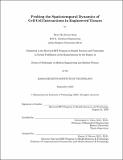Probing the spatiotemporal dynamics of cell-cell interactions in engineered tissues
Author(s)
Song, Hyun Ho(Hyun Ho Greco)
Download1227276833-MIT.pdf (22.78Mb)
Other Contributors
Harvard--MIT Program in Health Sciences and Technology.
Advisor
Christopher S. Chen.
Terms of use
Metadata
Show full item recordAbstract
Formation of capillary blood vasculature is a critical requirement for native as well as engineered organs and often dictates their growth and survival. in these tissues. Despite recent technological advancements such as 3D printing, the tissue engineering field still relies on vascular self-assembly to fabricate new blood vessels within an engineered tissue. Many efforts have utilized stromal fibroblasts as "feeder cells" to induce endothelial cells to undergo morphogenesis in vitro and facilitate engraftment of the vascularized tissues in vivo. However, the dispensability of these fibroblasts in different stages of vascular morphogenesis and engraftment is currently unknown and underexplored, and the ability to remove these feeder cells after assembly could be useful for clinical translation. The goal of this thesis is to 1) investigate this temporal interaction between endothelial cells and fibroblasts by employing microfluidic platforms and genetic tools and 2) use this insight to create implantable, feeder-free organs with perfusable vasculature. To achieve this, we first describe our microfluidic platform that allows for the functional vascularization of a 3D tissue through the endothelial cell and fibroblast co-culture. We then introduce a technique termed CAMEO (Controlled Apoptosis in Multicellular Tissues for Engineered Organogenesis), whereby fibroblasts are selectively ablated on-demand, and utilize it in our microfluidic devices to probe the dispensability of fibroblasts during vascular morphogenesis. The presence of fibroblasts is shown to be necessary only during the first few days of endothelial cell morphogenesis, after which these feeder cells can be ablated without significantly affecting the structural and functional features of the developed vasculature. Furthermore, we develop a scaled-up microfluidic platform for creating implantable tissues and use CAMEO to vascularize primary human hepatocytes that rapidly integrates with the host vasculature in vivo. We demonstrate that fibroblasts are necessary for the speedy integration of the implanted vasculature and the maintenance of hepatic function in vivo. In conclusion, our study suggests that transient, initial support from fibroblasts is sufficient to drive vascular morphogenesis in engineered tissues, and with further optimization, our strategy of engineering-via-elimination may provide a new general approach for achieving desired functions and cell compositions in engineered organs.
Description
Thesis: Ph. D., Harvard-MIT Program in Health Sciences and Technology, September, 2020 Cataloged from student-submitted PDF version of thesis. Includes bibliographical references (pages 95-106).
Date issued
2020Department
Harvard University--MIT Division of Health Sciences and TechnologyPublisher
Massachusetts Institute of Technology
Keywords
Harvard--MIT Program in Health Sciences and Technology.